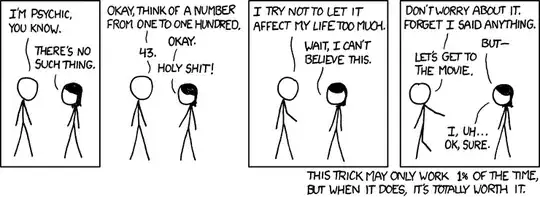An other approach, less to answer the question about statistics, but more about how to pull of the Trick.
There are 2 Methothds that you can do this.
One is trying to figure out, what number the other person is thinging based on tells (bodylanguage).
Example here and explained here.
The other one is more complicated, and needs a little preparation.
The second Method is called priming.
You can read about it here:
Priming is an implicit memory effect in which exposure to one stimulus
(i.e., perceptual pattern) influences the response to another
stimulus.
https://en.wikipedia.org/wiki/Priming_(psychology)
Suggestion is the psychological process by which one person guides the
thoughts, feelings, or behavior of another person.
https://en.wikipedia.org/wiki/Suggestion
It means, that you can try to subconciously implant (in your case) an number in someones brain, that they are more likely to choose. It works with all kinds of things, for example forms or music songs.
It's a technique used by many magicians and mentalists.
With this technique, you can not only guess with great accruracy, which number the other one will choose, but you can decide, which one it will be. This usually guarantees a mindblowing effect, because the suspect (mostly) didn't even notice, that you significly influenced his decision.
To answer your question:
You can not only predict a number with great accuracy, but you can even (with some effort) decide which one it's most likely gonna be.
Some use suggestive methods. It's harder to read someones mind but
easier to suggest what we should think of and make it seem as if they
reading our mind.
https://www.quora.com/Magic-illusion-How-does-David-Blaine-or-other-magicians-guess-the-number-card-that-you-are-thinking-of
You can see an example on the TV shows Cathrine Mills Mind Games (BBC) Breaking the Magician's Code: Magic's Biggest Secrets Finally Revealed or on various Appearances of Keith Barry.
Usually Magicians don't admit how they do their tricks, so it's hard to give a good example on how they pull it of and (have the same person) explaining it. But Keith barry does this on the Show "Deception with Keith Barry", which you can find a link to the video when you click on his name.
This is a simple example of how it works:
Answer the following questions:
What color is snow?
A Zebra is Black and?
What color is Rice?
A Wedding dress?
What does a cow Drink?
Answer is in the comments :)
